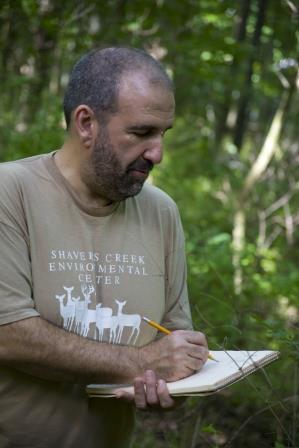DUBOIS – Two Penn State DuBois students have accomplished, as undergraduates, what many individuals as postgraduates still strive for. While working alongside Associate Professor of Biology and Forestry Robert Loeb, students Mary Transue, of Ford City and Porshe Garthwaite of Falls Creek penned an academic article that has been published internationally.
The trio’s work has been released in the latest publication of a renowned British journal, Studies in the History of Gardens and Designed Landscapes: An International Quarterly. The article is titled “None in Common, Many Unique: Species Selection for Gardens of the American South from 1734 to 1825.”
In the article, they detail the discoveries made during their extensive research into gardens of colonial America, specifically those located in what is today the southern United States. They studied records kept by gardeners at the time, who carefully recorded what was planted, what grew successfully, and what didn’t.
“I was most surprised that records were well kept by early American horticulturalists and preserved for future researchers such as our team to use and study,” said Transue, a senior in the Earth Science program who aspires to teach environmental science on the middle school level.
Loeb, Transue and Garthwaite concluded that horticultural practices during this time period helped to shape the entire society we live in today. By studying the plants people chose to grow at that time and the processes they used to successfully nurture these plants, an often forgotten facet of American history was brought to light. Especially since some of the very gardens Loeb and the students studied were those of George Washington and Thomas Jefferson, among many other colonial gardeners.
“These people were the founding fathers, not only of our nation, but also of American horticulture. Loeb said. “This shows an additional, little-known way that they shaped our society.”
Loeb explained that early American gardeners had to do a great deal of experimenting to figure out what they could grow in unfamiliar conditions, attempting to garden with plants brought from the Europe, as well as those native to America.
“It truly was a new world,” Loeb explained. “Conditions didn’t always accommodate the horticultural practices they used in Europe. They became great innovators. We cannot view colonial gardens as being primitive. They were very sophisticated; more sophisticated than we think.”
As indicated in the title of the article, “None in Common, Many Unique,” the collections of plant species found in colonial gardens were extremely diverse. In fact, the group studied a total of six gardens; three located in towns, and three located at plantations, and uncovered evidence of a combined 845 unique plant species in the six locations. Out of that total of 845 total species that were grown, no single species was shared by all six gardens studied.
“I was surprised by our results,” Garthwaite, an Earth Science major, remarked. “I expected there to be more species in common among the three town and plantation gardens we compared.”
Experimentation, as well as unstandardized supplies of plants, led to the variety of species grown. Another reason for such diversity in plant selection is that these horticultural pioneers knew that if a blight or infestation took out a crop, that dissimilar crops would likely not be susceptible to the same danger and survive, providing food.
In the end, this diversity of selected plants offered clear indications of what would thrive, and what would not in the American landscape, leading to gardening practices and traditions that still survive today. But for the colonial gardener, this was no hobby, but another historical case of necessity fostering innovation.
“It was an agrarian society, plants were very important. A family would literally live or die depending on what they chose to plant in their garden or farms,” said Loeb, indicating the colonial farmer’s motivation to keep such detailed gardening records.
For the students, those records provided the base for a real-world research project that allowed them to further their educational experience outside of the classroom.
Garthwaite said, “Working alongside Dr. Loeb on this academic research project and paper was a great experience. I thought Dr. Loeb chose a really interesting topic. He was also very excited about the project and that was helpful.”
Transue is certain she’ll use lessons she learned during this project in her future career. She said, “The experience has taught me many organizational, analytical and teamwork skills. I believe it was a valuable experience in researching and interpreting the complex data and historical information.
“These skills have carried over to my other classes and my future plans to teach. The one aspect I enjoyed the most was working as a team to meet deadlines in order to reach our goal of publication.”
To the scientific and historical communities, there is now one more resource that can be used to chart the American journey though time.
“This was a very historic period. Understanding what life was like, day to day, by studying things like the foods they grew, helps us to better understand how our society was shaped,” Loeb said.
